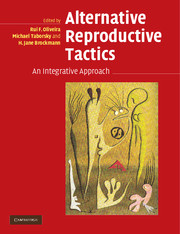Book contents
- Frontmatter
- Contents
- List of contributors
- Preface
- 1 The evolution of alternative reproductive tactics: concepts and questions
- PART I ULTIMATE CAUSES AND ORIGINS OF ALTERNATIVE REPRODUCTIVE TACTICS
- PART II PROXIMATE MECHANISMS OF ALTERNATIVE REPRODUCTIVE TACTICS
- PART III TAXONOMIC REVIEWS OF ALTERNATIVE REPRODUCTIVE TACTICS
- 8 Alternative reproductive tactics in insects
- 9 The expression of crustacean mating strategies
- 10 Alternative reproductive tactics in fish
- 11 Alternative reproductive tactics in amphibians
- 12 Alternative reproductive tactics in reptiles
- 13 Alternative reproductive tactics in birds
- 14 Alternative reproductive tactics in nonprimate male mammals
- 15 Alternative reproductive tactics in primates
- PART IV EMERGING PERSPECTIVES ON ALTERNATIVE REPRODUCTIVE TACTICS
- Index of species
- Subject index
- References
11 - Alternative reproductive tactics in amphibians
Published online by Cambridge University Press: 10 August 2009
- Frontmatter
- Contents
- List of contributors
- Preface
- 1 The evolution of alternative reproductive tactics: concepts and questions
- PART I ULTIMATE CAUSES AND ORIGINS OF ALTERNATIVE REPRODUCTIVE TACTICS
- PART II PROXIMATE MECHANISMS OF ALTERNATIVE REPRODUCTIVE TACTICS
- PART III TAXONOMIC REVIEWS OF ALTERNATIVE REPRODUCTIVE TACTICS
- 8 Alternative reproductive tactics in insects
- 9 The expression of crustacean mating strategies
- 10 Alternative reproductive tactics in fish
- 11 Alternative reproductive tactics in amphibians
- 12 Alternative reproductive tactics in reptiles
- 13 Alternative reproductive tactics in birds
- 14 Alternative reproductive tactics in nonprimate male mammals
- 15 Alternative reproductive tactics in primates
- PART IV EMERGING PERSPECTIVES ON ALTERNATIVE REPRODUCTIVE TACTICS
- Index of species
- Subject index
- References
Summary
CHAPTER SUMMARY
Frogs and salamanders, the two most diverse lineages of amphibians, differ significantly in reproductive mode, morphology, and behavior. We review reproductive tactics in these lineages and consider their distribution among taxa in light of phylogeny, ecology, and organismal traits. Together these groups show a surprising diversity of alternative reproductive phenotypes that can roughly be divided into two classes: those that increase an individual's chance of mate acquisition (e.g., satellite or intercepting males) and those that directly increase fertilization success (e.g., spermatophore capping, clutch piracy, or multimale spawning). Our survey underscores the fact that mode of fertilization (internal or external) and operational sex ratios at breeding aggregations have important implications for the frequency and nature of alternative reproductive tactics. However, our understanding of the evolution of amphibian alternative reproductive tactics is hampered by a lack of detailed information for many species. For example, most alternative tactics have been described in temperate amphibians despite the fact that tropical species account for most of the taxonomic, morphological, behavioral, and ecological diversity in this group. A challenge for future studies will be to further describe and categorize the diversity of reproductive tactics in amphibians to uncover general patterns within and across lineages in the factors that modulate polymorphism in reproductive phenotypes.
INTRODUCTION
In the last few decades, organismal evolutionary biologists have become increasingly aware of inter-individual differences in mate acquisition abilities that may underlie the evolution of alternative strategies or tactics for reproductive success (Shuster and Wade 2003).
- Type
- Chapter
- Information
- Alternative Reproductive TacticsAn Integrative Approach, pp. 300 - 331Publisher: Cambridge University PressPrint publication year: 2008
References
- 30
- Cited by



